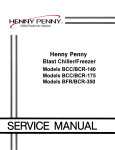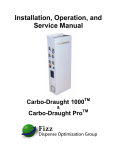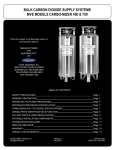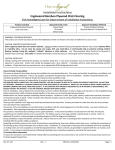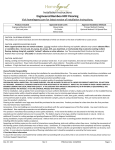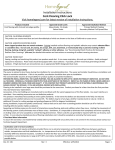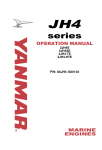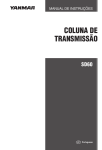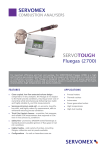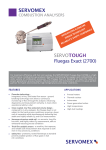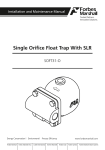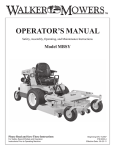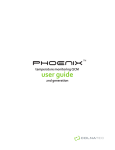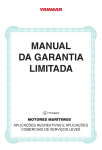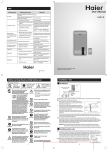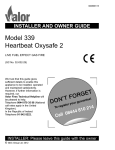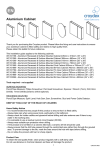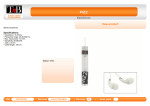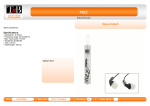Download Installation, Operation, and Service Manual Nitro
Transcript
Installation, Operation, and Service Manual TM Nitro-Draught - 1000 TM Nitro-Draught - Pro TM Nitro-Draught - Max Blend Gas Dispense Systems Section 1 – Introduction The Nitro-Draught brand blend gas dispense system extracts nitrogen (N2) from ambient air, blends it with carbon dioxide (CO2) and supplies the mixed gas to a draught beer dispense system. As a component of a properly designed and maintained beer system, the Nitro-Draught assures brewery quality beverage presentation while it eliminates excessive foaming and wasted beer. The Nitro-Draught system uses proven Pressure Swing Adsorption (PSA) technology with Carbon Molecular Sieve (CMS) to separate N2 from the atmosphere and store it at a purity level of at least 99.8%. It uses a mechanical blender to combine the N2 with CO2 from another storage vessel into two CO2 / N2 “beer gas” blend ratios, commonly 25% / 75% and 60% / 40% respectively. These blends are consistent and accurate to within 2% CO2 of each blend ratio. Blends can be customized for any application. This manual contains the information necessary for the correct use of the Nitro-Draught 1000, Nitro-Draught Pro and Nitro-Draught Max. Should any questions arise regarding safe and proper installation, operation or maintenance of the Nitro-Draught system, contact the supplier before proceeding. Warning: Ensure that all personnel involved in the installation, operation and maintenance of the Nitro-Draught system, as well as those persons who will act as supervisory personnel, have read and fully understand the instructions before attempting to install, operate or perform maintenance on the unit. 2 Section 2 – Contents Section 1 Introduction page 1 Section 2 Contents of the Operating Manual page 2 Section 3 Alert Symbols page 3 Section 4 Safety Warning page 3 Section 5 General Information, System Schematics page 4 Section 6 Possible causes of blend gas pressure loss page 6 Section 7 System Leaks page 6 Section 8 Product Specifications page 7 Section 9 Unpacking the Nitro-Draught unit page 8 Section 10 Installation and Operation of the unit page 8 Section 11 Maintenance page 11 Section 12 Troubleshooting Guide page 14 Section 13 Service and Parts page 15 Section 14 P & I Diagram / Electrical Wiring Diagram page 16 Section 15 Warranty page 17 3 Section 3 - Alert symbols used throughout this manual WARNING: The WARNING symbol draws attention to an operating procedure or practice that can cause injury if it is not observed or performed correctly. Do not continue past a WARNING symbol until you have fully understood or satisfied the indicated conditions. CAUTION: The CAUTION symbol draws attention to an operating procedure or practice that can damage the unit if it is not observed or performed correctly. Do not continue past a CAUTION symbol until you have completely understood or satisfied the indicated conditions. NOTE: The NOTE symbol draws attention to information that is especially important to an operating procedure or a practice that is advisable to perform correctly or observe correctly, but that cannot damage the unit. Section 4 - Safety Warning Do not operate the Nitro-Draught unit until the information contained in this document has been read and understood by all personnel concerned. The unit should be connected to an electrical supply in accordance with local safety regulations. Ensure that the rating plate corresponds to the supply voltage. Ensure that the unit is grounded. Nitrogen (N2) & carbon dioxide (CO2) are not poisonous gases but in a concentrated form present a risk of asphyxiation. The Nitro-Draught unit produces a small flow of mixed gases that quickly disperse in the atmosphere. However, do not directly inhale any gases produced by the unit. Refer to Compressed Gas Association publications for further information. Before service or maintenance is performed on the Nitro-Draught system, the electrical supply must be switched off and the main electrical cord disconnected. All personnel handling, using or maintaining the Nitro-Draught unit must employ safe working practices and observe all relevant local health and safety regulations. 4 Section 5 - General Information CO2 is supplied to the Nitro-Draught from a bulk storage vessel or high pressure CO2 cylinder. The CO2 to the Nitro-Draught should be regulated to between 90 – 300 psi. The Nitro-Draught produces nitrogen (N2) by separating it from the atmosphere using a Carbon Molecular Sieve (CMS). The N2 is stored in an external receiver vessel. While producing N2 the internal sieve column will depressurize on a regular 1-3 minute cycle, resulting in an audible pulse of gas, which is normal. By blending the CO2 with the N2, Nitro-Draught units will output up to two different mixtures of carbon dioxide (CO2) and nitrogen (N2) simultaneously at pre-determined ratios. Unblended nitrogen can be dispensed from the external nitrogen storage vessel if needed. The standard blend ratios can be customized if the application requires. Standard blends are: Blend 1 = 25% CO2 / 75% N2 Blend 2 = 60% CO2 / 40% N2 Nitro-Draught units are classified as non-hazardous for transportation purposes and non-flammable for fire regulations. Any interference with the calibration warning labels will invalidate the Nitro-Draught unit warranty and may incur costs for re-calibration. 5 6 7 Section 6 – Possible causes of blend gas pressure loss • • • Check the on/off switch (No.7 on Schematic B) on the side of the Nitro-Draught cabinet to ensure the green switch is illuminated. If the green switch is not illuminated, check that the power cord is securely connected to the unit and to the power supply outlet and that any external fuse or circuit breaker has not tripped. Check the keg tap couplings to be sure they are secure. • Check the CO2 inlet gauge on the unit (location No. 2 on Schematic B), to verify that the supply pressure is at least 60 psig (4.1 barg). If the gauge pressure is low, switch to the regulated back-up cylinder (if equipped). Regulate the backup source to 90 psig. With assistance from your service supplier, determine and correct the cause of low CO2 pressure. Check the N2 supply pressure (No. 4 on Schematic B) to verify that it is above 60 psig (4.1 barg). If the pressure is below this figure, bring the regulated back-up cylinder (if equipped) into service. Regulate the back-up source to 90 psig. Call for assistance from your supplier to determine and correct the cause of low N2 pressure. If either the CO2 supply or the N2 supply stops, the blender within the Nitro-Draught unit will stop supplying gas to the beer dispense system. Blend production will resume when gas pressure is restored. If either of the gas input supply pressures drops but stays above keg pressure, the blender will continue to produce blended gas, but at a corresponding slower rate and with less blend accuracy. Section 7 - System Leaks If a loss of pressure is due to obvious leakage or rupture of a gas supply line, take the following actions: • • • • Do not enter the area of leakage until it is safe to do so (refer to supplier Material Safety Data Sheets). Ensure the area is well ventilated before entering. Turn off all cylinders if they are accessible and are away from the leakage area. Switch off the Nitro-Draught unit and contact your service supplier for advice. Section 8 - Product Specifications • Model: Nitro-Draught 1000 (Part No. 79001) 8 • • • • • • • • • • • • • • Nitro-Draught Pro (Part No. 79002) Nitro-Draught Max (Part No. 79003) Dimensions: Height - 24.5in /623mm (1000, Pro), 31in /785mm (Max) Width - 13.6in /345mm Depth - 14.8in /375mm Total Weight: Nitro-Draught 1000, Pro - 77lb/35kg Nitro-Draught Max - 110lb/50kg Mounting Hole Spacing: 16 in (Horizontal) center to center Electrical Power Supply: 115 Vac 60 Hz Ambient Temperature: 36 to 95ºF (+2 to +35ºC) N2 Storage Vessel Size: Approx 30 gal/ 114 liters (Part No. 77001) N2 Production Rate: Nitro-Draught 1000 - Approx 0.035 cfm (1 L/min) Nitro-Draught Pro - Approx 0.07 cfm (2 L/min) Nitro-Draught Max - Approx 0.175 cfm (5 L/min) Nitrogen Purity: >99.8% (<0.2% oxygen) N2 Generation Cycle Start/Stop Pressures: ND 1000, Pro - 94psig (6.5barg) / 102psig (7.0barg) ND Max – 131psig (9.0barg) / 138 psig (9.5barg) Stored N2 Volume @ Max Press: 3 ND 1000, Pro - 31 ft (approx. 876 L) 3 ND Max - 42 ft (approx. 1190 L) Min CO2 Gas Requirement: 90 psig (6.2 barg) Mixed Blends (CO2 /N2): (25% / 75%) & (60% / 40%) Blend Outlet Pressure: 72.5 psig (5 barg) Inlet and Outlet Bulkhead Ports: 1/4” FNPT Section 9 – Unpacking the Unit Remove the items from the box and check for damage. The box contains one Nitro-Draught unit, a manual, wall mounting assembly and a bag containing a power cord. If any of the items are in a damaged condition, request an immediate inspection by the carrier. If any of the items are missing, please contact Fizz. Section 10 – Installation and Operation The Nitro-Draught unit can be either mounted to a wall or on top of a suitable flat surface. A suitable surface is one that will support the weight and vibration of the unit as well as protect the unit from damage 9 from impact, moisture, excessive heat etc. The Nitro-Draught units must be mounted in a vertical position. The location for mounting the Nitro-Draught unit should be indoors in an area that is well ventilated and where the ambient temperature is between 36ºF and 95ºF. Ensure that the wall or supporting member of the wall is capable of bearing 110 lb (50kg). The mounting location must have access to a 115V ac electrical supply with a three pin socket. Ensure that the electrical supply circuit has adequate capacity for consistent power supply to the compressor motor. Take into account the location of a properly regulated CO2 source and space for the N2 storage tank. The N2 storage tank CAN be located distant from the Nitro-Draught unit with no adverse effects on the operation of the system. Make sure the mounting position allows access to the side of the cabinet for making connections and for viewing operational displays. The attachment means, must be suitable for the type of wall construction and capable of supporting the full weight the Nitro-Draught unit, which is approximately 77lb (35kg) for Nitro-Draught 1000 / Pro and 110lb (50kg) for Nitro-Draught Max. PLEASE WEAR EYE PROTECTION WHILE INSTALLING THE UNIT. The use of noxious chemicals or machinery that produces fumes is not permitted within a 20 ft. radius of a Nitro-Draught installation site. Ensure that there are no electrical devices below the Nitro-Draught unit, as condensate (water) may drip from the Nitro-Draught unit. Wall Mounting Kit Description and Instructions The Nitro-Draught system is supplied with a kit to be used for wall mounted installations. It is the installer’s responsibility to use proper fasteners and installation techniques to ensure a safe installation. Pay particular attention to the weight of the unit and the tendency for vibration to loosen fasteners. Use Loctite or similar products to lock all fasteners. This illustration is meant to demonstrate the function of each part contained in the installation kit. Proper mounting of the brackets to the wall is the installer’s responsibility and will vary depending on the wall construction. Items Contained in Kit 10 Step One Using a level; mark wall using OUTER holes in Cross Bar. These marks will locate the mounting holes for the Wall Brackets. Fasten Wall Brackets to wall using appropriate fasteners for type of wall construction. Step Two Bolt Cross Bar to outside back of Nitro-Draught through INNER holes on Cross Bar using supplied slotted bolt and nuts. Bolt Rubber Bumper to lower back of Nitro-Draught if needed. 11 Step Three Hang Nitro-Draught by resting Cross Bar into Wall Brackets. Lock Cross Bar to Wall Brackets by screwing the provided phillips head screws through OUTER holes in wall brackets. Supplies To Have On Hand (not supplied with Nitro-Draught unit): • Reinforced Beverage Tubing (red line) 1/4” ID (Fizz P/N 14010) 12 • Hose Clamps (Oetiker #13.3) for 1/4” tubing (Fizz P/N 13001) • Hose Barb Fittings (1/4” x 1/4 NPT) (Fizz P/N 1611322) • Isolation (Ball) Valves (1/4 NPT x 1/4 FPT) (Fizz P/N 1716162) (One recommended in each line to facilitate pressure tests and to isolate components for service and switch over) • Pressure Gauge, * 0-160 psig (1/4” CUM) (Fizz P/N 10919416) or • Pressure Gauge, * 0-160 psig (1/4” bot mount) (Fizz P/N 2014649) • Street tee (1/4” NPT) (Fizz P/N 1211702) (For connection of an optional CO2 supply line gauge) • Hose Barb Tees (1/4”) (Fizz P/N 1611612) (For in-line connection of optional back-up gas cylinders and for “splitting” blend lines if necessary) • 1/2” PTFE thread sealant tape Fizz recommends the use of a pressure gauge at the CO2 inlet port (Schematic A) to assure that at least 90 psi supply pressure is being delivered to the unit. CO2 pressure is regulated internally to ensure blend purity. Connect the “N2 To Storage” port of the Nitro-Draught cabinet with the inlet port on the N2 storage tank using 1/4” I.D. beverage tubing, hose barb fittings and stepless clamps. Installation of an ‘in-line’ isolation valve is recommended. The N2 storage tank is fitted with an isolation valve. Open this valve. Connect the outlet port of the N2 storage tank with the “N2 From Storage” port on the Nitro-Draught cabinet using 1/4” I.D. beverage tubing, hose barb fittings and stepless clamps. Installation of an in-line isolation valve is recommended either at the outlet port of the N2 storage tank or the “N2 From Storage” port on the Nitro-Draught cabinet. (The N2 storage tank is already equipped with this isolation valve.) Close this valve. An optional, regulated back-up N2 cylinder can be connected in-line using a barbed tee connection. If a back-up cylinder is connected, its gas supply valve should be turned off. Attach isolation valves to the CO2 inlet port and to the outlet ports for Blend 1 and Blend 2 on the cabinet. Close these valves. Now the NitroDraught is ready to begin N2 generation for the storage tank. Note: The Nitro-Draught may take 14 hours to fully pressurize an “empty” storage tank. The Nitro-Draught Pro unit will require 6 to 7 hours to fully pressurize an empty storage tank. To save time, Fizz recommends that 13 the storage tank be pre-pressurised to 80 - 90 psig using a regulated supply of N2 from a high- pressure cylinder. Complete the storage tank pressurization by operating the unit to assure that the system is performing properly and is ready to be put into service. Electrical Power-Up The unit must be connected to a suitable 115V ac grounded electric supply in accordance with local safety regulations. Ensure the rating plate corresponds to the supply voltage. Ensure there is power at the 3-pin (grounded) socket. Using the power cord supplied with the Nitro-Draught unit, connect the unit to the power supply. Switch the ON/Off Main Switch to the “ON” position and ensure that the green switch illuminates. Note: The cooling fan motor will start immediately and after approximately 120 seconds the on-board compressor will start. The Nitro-Draught’s nitrogen generation process will consist of an approximate 1 1/2 minute compressor run time alternating with an exhaust time of about two minutes. The Nitro Draught Pro’s nitrogen generation process will consist of an approximate two minute compressor run time alternating with an exhaust time of about 1 1/2 minutes. The Nitro Draught Max’s nitrogen generation process will consist of an approximate two minute 10 seconds compressor run time alternating with an exhaust time of about 2 minutes. An audible pressure release will indicate that the unit is producing N2. In normal operation this audible cycle will continue. In the event of low or zero flow requirement the cycle will continue until the N2 storage vessel is fully pressurised where upon the unit will cease cycling and shutdown. This energy saving mode is shown via the green Economy Light on the side of the unit. When the pressure falls the unit will re-enter normal operation. Locate and Connect the CO2, Blended Gas and Pure N2 Lines While the N2 storage tank is being pressurised, determine a connection point to the main CO2 supply line. (Ensure that the CO2 supply pressure is at least 90 psi.) Determine the blend gas supply line connection points to the draught beer system and to the pure N2 use connection point as needed. Final connections and leak testing will cause a brief interruption of service to the beer faucets and should be accomplished when the establishment is closed or when no beer is being poured. Make the CO2 and the blend gas supply line connections after the N2 storage tank is 14 fully pressurised to minimize draught system downtime. Be sure the gas supply (pressure) from the CO2 storage vessel is turned off or restricted at the connection point before making the CO2 connection. Connect the CO2 inlet port on the Nitro-Draught unit to the CO2 supply line connection point using beverage tubing, hose barb fittings and stepless clamps. Run the 1/4” ID blend-gas supply lines from the Nitro-Draught unit to the beer gas connection points. Connect the lines to the Nitro Draught’s blend supply points. Color-coded supply lines are recommended to make sure that Blend 1 (25% CO2 / 75% N2) and Blend 2 (60% CO2 / 40% N2) are routed to the correct beer types. For example, red-line beverage tubing may be used for Blend 1 and green-line beverage tubing used for Blend 2. Relieve pressure at the beer gas connection points. Avoid depressurizing the kegs. Connect the blend-gas supply lines to the designated beer gas connection points. Restore the main CO2 supply pressure. Open the “CO2 inlet” valve on the Nitro-Draught unit. Open the “N2 From Storage” valve. All isolation valves except the blend outlet isolation valves should now be open. Observe pressure gauges and examine all connections for leaks. When the N2 storage tank is fully pressurised and the N2 pressure gauge remains steady, the Nitro-Draught unit should be in the “rest” mode and the compressor will be off. If the N2 pressure falls while the blend outlets are closed this indicates leakage in the upstream connections or within the Nitro-Draught unit. Locate and correct the leak(s). To check for blend-gas leaks to the beer system, open the red valves on the blend-gas pressure control modules. Pressurize the blend gas supply lines by adjusting the regulators to the proper beer system specifications. Ensure that no beer is being dispensed. The N2 supply pressure gauge may show a small pressure drop at first but should stabilise. Blend-gas line pressure should be stable at the pressure set by the beer system installer. If pressure continues to drop, locate and correct the leak(s) in the draught system. (Ensure that all beer tap couplings are secure.) The beer-gas system may have leaked before the Nitro-Draught was installed. Leaking keg tap couplings are common. The leak(s) likely go 15 unnoticed (except through excessive gas consumption). If that is the case, the Nitro-Draught’s compressor may run excessively or appear to be unable to keep the N2 storage tank adequately pressurized during offbusiness hours. Check all gas line connections, including the keg couplings, for leaks. Section 11 - Maintenance Before performing maintenance on a Nitro-Draught unit, disconnect the main power supply. Failure to perform specified service may result in damage to the NitroDraught unit and may invalidate any warranty. Use only genuine parts as supplied by Fizz. The quality and reliability of the Nitro-Draught unit is maintained through preventive maintenance performed on a scheduled, regular basis. 16 Although the frequency of this maintenance is determined by particular use conditions, Fizz recommends filter changes at least every twelve months. Keep a written record of all maintenance activity. Filter Replacement (Use Filter Kit P/N 11705321) Switch off the electrical power supply before performing any service on a Nitro-Draught unit. Close the “CO2 Inlet” and N2 To Storage” Isolation valves. Depressurise the system by switching the unit on again for 20 seconds allowing it to exhaust (and depressurize). Shut the unit off. Note: If the storage system is full pressurized, the internal tubing will need to be depressurized by slowly turning out the drain tube retaining nut attached to the elbow on the bottom of the coalescing filter bowl. Replace the Air Intake Filter: (Figure 1) Twist the cap of the filter housing in a counter clockwise direction separating it completely. (Figure 1a) 2.) Pull the filter element from the housing cap and dispose of the element. (Figure 1b) 3.) Fit the replacement element by pushing the element, wide end first, into the housing cap. (Figure 1c) 4.) Replace the housing cap (with new filter) turning it clockwise by hand until it snaps tight. (Figure 1d) 17 Figure 1 Replace the Coalescing Filter: (Figure 2) 1.) Make sure the housing is completely depressurized before continuing. 2.) Unscrew the bowl and remove the head. (Figure 2a & 2b) 3.) Remove the element from the bowl and dispose in accordance with local waste regulations. (Figure 2c) 4.) Carefully remove the element from the packaging and insert into the bowl.. (Figure 2d) 5.) Replace the head and screw onto the bowl. (Figure 2e) Figure 2 Ensure the internal pressure is completely relieved by slowly unscrewing the tube retaining nut on the elbow at the bottom of the filter housing bowl. Disconnect the drain tube. Do not remove the elbow from the housing. 2.) Unscrew the bowl and remove the head. (Figure 2a & 2b) 3.) Remove the element from the bowl and dispose in accordance with local waste regulations. (Figure 2c) 4.) Carefully remove the element from the packaging and insert into the bowl.. (Figure 2d) 5.) Replace the head and screw onto the bowl. (Figure 2e) 6.) Refit the drain tube to the filter housing bowl. Replace the Silencer Filter Assembly: (Figure 3) 1.) Unscrew the silencer (counter clockwise) from the solenoid valve (Figure 3a). Dispose of the silencer. Notice that the silencer is comprised of an outer, blue porous plastic “housing” with a sintered brass insert. Both pieces are replaced and therefore do not need to be separated unless for disposal reasons. 18 2.) Screw the replacement silencer onto the solenoid valve’s fitting until it is hand tight. (Figure 3b) 19 Section 12 - Troubleshooting Guide for Service Agent Indication Possible Cause Corrective Action Poor power cord connection / blown power fuse Be sure the power cord is securely connected to the power supply outlet and to the unit. Check / replace 10A fuse located in power socket Incorrect input voltage Check ‘main’ voltage and rating number plate for voltage spec External fuse blown or circuit breaker tripped Check fuse; replace if necessary. Reset circuit breaker; check for overload On/Off switch failure Verify power to unit. Replace switch. Unit is in economy mode until storage pressure to 94 psi Check green economy light Internal leak in Nitro Draught unit Close “N2 outlet to storage” valve, run unit to max pressure, check and correct compressed air and N2 pressure circuit / fitting leaks Leak in N2 storage or supply line Leak-check line fittings and connections. Correct leak(s) Leak in beer gas circuit or keg coupling Ensure keg tap couplings are secure. Check gas line and regulator connections Power off Check on/off switch and power circuit Low CO2 inlet (line) gauge pressure (below 60 psi) Check CO2 supply (tank) pressure and contents. Ensure valves are open Out of CO2 Switch to back-up CO2 if equipped. Have CO2 storage tank refilled Low N2 storage pressure (below 60 psi) If green and amber LED’s are on and compressor is cycling Temperature problem Check cooler and pour temperatures Incorrect dispense gas pressure Check pour rate. Check dispense gas pressure at the keg. Consult with beer system installer or beer distributor Green power switch not Illuminated Green power switch illuminated but no operation N2 storage (tank) pressure drops during period of no use. Compressor motor runs excessively; unable to reach maximum N2 storage pressure Low blend gas pressure; beer pouring slow Excessive beer foaming 20 Section 13 - Service and Parts Service and Maintenance 1.) Service or maintenance on the Nitro Draught - 1000, Nitro Draught Pro and Nitro Draught Max should be performed only by Fizz trained and authorised professional service agents who are familiar with mixed gas pressure systems and all pertinent safety and service procedures. Fizz recommends the use of Fizz approved replacement parts. 2.) Before calling your service agent or CO2 supplier for service or troubleshooting assistance, please have the following information: -Serial number of the Carbo-Draught unit -Description of the situation Readings from pressure gauges (CO2 supply, N2 storage, Gas Blend Supply) Temperature of cooler and beer at faucet if appropriate. -Special observations such as excessive beer foaming or continuous compressor operation. 3.) Fizz recommends that a thorough preventive maintenance check be performed on the Nitro Draught - 1000 and on the Nitro Draught Pro & Max system annually by a qualified professional service agent. Replacement of the compressor air inlet filter, the coalescing filter, and the silencer filter assembly should be performed at least every twelve months or more frequently, depending on environmental conditions. Filter kit: Fizz P/N 11705321. 4.) The Nitro Draught units have no user serviceable parts. All service work should be performed by an authorised professional service agent. Service or modifications performed on the system by unauthorised persons will void the warranty. Important Telephone Numbers: Nitro Draught System Installer: ___________________________________ Nitro Draught / CO2 Service Agent: _______________________________ Fizz Dispense Optimization Group: (800) 253-6610 [toll free in U.S] http//shop.fizzdog.com 21 22 23 Section 15 - Warranty Warranty Policy Fizz Dispense Optimization Group, LLC warrants to the Purchaser the Nitro Draught System shall be free from any defects in workership and materials for 24 months from the date of shipment from Fizz. Purchaser agrees that as a pre-condition to any Fizz liability hereunder, Purchaser or its appointed agents shall fully inspect all goods immediately upon delivery and shall give Fizz written notice of any claim or purported defect within ten (10) days after discovery of such defect. Use of the Carbo-Draught system without the recommended inlet air quality (Section 10 of this manual) or genuine parts will expressly invalidate the warranty. As a further pre-condition to any Fizz liability hereunder, parts replacement and labour must be supplied by a Fizz approved service company. Fizz may elect to repair or replace such equipment or any defective component or part thereof which proves to be defective, or to refund the purchase price paid by the original Purchaser. Fizz shall not be liable for defects caused by the effects of normal wear and tear, erosion, corrosion, fire, explosion, misuse, or unauthorised modification. Alterations or repair by others than those designated and approved by Fizz or operation of such equipment in a manner inconsistent with Fizz accepted practices and all operating instructions, unless pre-authorised in writing by Fizz, shall void this Warranty. Fizz’s sole and exclusive liability under this Warranty is to the Purchaser and shall not exceed the lesser of the cost of repair, cost of replacement, or refund of the net purchase price paid by the original Purchaser. Any accessories, parts and equipment supplied by Fizz but not manufactured by Fizz shall carry whatever warranty the manufacturer has given to Fizz providing it is possible for Fizz to pass on such warranty to the customer. Fizz is not liable for any losses (including CO2), damages, or costs of delays, including incidental or consequential damages. Fizz specifically makes no warranties or guarantees, expressed or implied, including the warranties of merchantability or fitness for a particular purpose or use, other than those warranties expressed herein. WARRANTY CLAIMS PROCEDURE 1.) All warranty claims must be previously authorized by Fizz Inc. Telephonic / electronic approval may be obtained by contacting Fizz Inc. Technical / Customer Services at: -Telephone: 0800 - 253 - 6610 24 -Facsimile: 678 - 792 - 7784 or by writing to: Fizz Dispense Optimization Group, LLC PO Box 1003 ADAIRSVILLE GA 30103 USA 2.) Authorization must be obtained from Fizz prior to shipping any equipment to Fizz facilities. The model and serial number of the unit must be provided in order to process the return. If approved, a Return Material Authorisation (RMA) number will be provided. The RMA number must be prominently indicated on the packing slip and any packaging that accompanies the goods being returned. The customer returning the goods is responsible for all freight, proper packing, and any damage incurred during shipment of the goods back to Fizz. 25 26 27



























